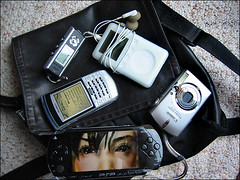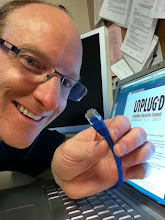
I like to see the classroom as a learning commons, where individuals can tap into a range of devices to further individual and small group inquiry. In a project-based learning environment, the need for technology should vary widely among both teacher and student learners. Why not frame a classroom around a kit of enabling devices, designing an ecosystem to support the needs of groups and individuals?
The On-Demand Ecosystem:
Hand-held Devices:
 In an ideal world, students will have permission to enable their personal devices on the school network. I would augment such an approach with shareable hand-helds, ensuring that each student would have access to e-books, apps, and cloud-based resources. While most of the apps available for the iPod and iPad are not built for rich media production, I will outline my argument for their adoption in a subsequent post. Suffice it to say, I suspect that these tools and their offspring will become the centerpiece of the learning commons.
In an ideal world, students will have permission to enable their personal devices on the school network. I would augment such an approach with shareable hand-helds, ensuring that each student would have access to e-books, apps, and cloud-based resources. While most of the apps available for the iPod and iPad are not built for rich media production, I will outline my argument for their adoption in a subsequent post. Suffice it to say, I suspect that these tools and their offspring will become the centerpiece of the learning commons.Notebook computers:
 At the outset, I'd suggest a ratio of 1 machine for every 4 students. Beyond speaking to the collaborative nature of Classroom 2.0, such an approach would lead all to value the interdependence of learners and devices alike. As the most capable devices in the ecosystem, these shared machines would do the heavy lifting for groups tasked with digital storytelling; media development; and online publishing.
At the outset, I'd suggest a ratio of 1 machine for every 4 students. Beyond speaking to the collaborative nature of Classroom 2.0, such an approach would lead all to value the interdependence of learners and devices alike. As the most capable devices in the ecosystem, these shared machines would do the heavy lifting for groups tasked with digital storytelling; media development; and online publishing.Audio tools: Microphones, headsets, and speakers should be available for recording and playback. Securing a set of devices for each notebook computer seems sensible.
Digital Cameras: Used to create raw content for later post-production, these devices would capture evidence of learning, while facilitating the emergence of wide-ranging multimedia products.
Scanner: Whether scanning documents, photographs, or artwork, the scanner would ideally be accessible by any notebook computer.
Document Camera: An opaque projector for modern times, this device is perfect for the sharing print media; screens from hand-held devices; and other 2D and 3D offline content.
Projector: Whether touch sensitive or not, this presentation device might be paired with the teacher's computer to facilitate teleconferencing and large group instruction. In providing an area of focus, it would also be leveraged by individuals, partners and groups to share their learning.
You may note that I've neglected to include a printer. What does this say about the learning commons I'd prefer to see? Am I missing anything else? Which tool you see as critical to the design of Classroom 2.0?
Photo Credits: Adam Melancon; angela.a.acevedo; Burnt Pixel



